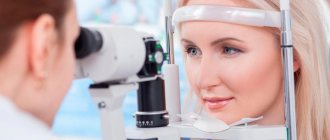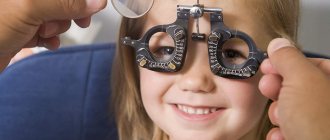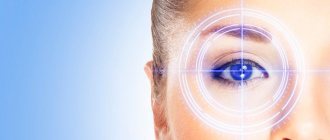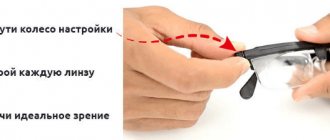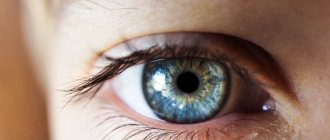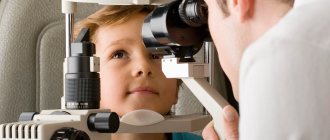Vocabulary: Some important terms to understand
AAPOS
: American Association for the Study of Pediatric Ophthalmology and Strabismus.
It is the official association of pediatric ophthalmologists
and oculomotor specialists in North America.
To become a full-time member of this organization, an ophthalmologist
must have at least one year of membership in an AAPOS-approved training program.
This year, training is devoted exclusively to the diagnosis and treatment of eye diseases in children (including strabismus
), as well as diseases in adults suffering
from strabismus
. For more information, visit www.aapos.org
AACO
: The American Association of Certified
Orthoptists
(AACO) is the official association
of orthoptists
in the United States of America.
To become a member, an orthoptist
must first complete a full course of training in an AACO-approved curriculum and then pass a written and oral examination.
Accommodation _ _
: The process by which the focal length of the eyes changes from far to near vision.
This is also the process by which a hypermetropic
child can overcome and compensate
for hyperopia
(farsightedness).
Accommodative esotropia ( Accommodative
Esotropia )
: intersection of the optical axes of the eyes (see
esotropia
), due to the need for focusing (
accommodation
) and
hyperopia
(
farsightedness
).
Amblyopia ( Amblyopia )
: visual impairment, usually only in one eye, which cannot be improved directly by wearing glasses, since the visual impairment is caused by certain structural disorders of the eyes, such as cataracts, the presence of internal scars, etc. In common parlance, such an eye is called “lazy” because the deterioration in vision is the result of the fact that the image from that eye is not used.
Astigmatism _ _
: an optical aberration of the eye that causes distortion in both near and far (distance) vision.
Binocularity _ _
: The normal process of seeing with both eyes at the same time.
Cataract _ _
: Loss of transparency or clouding
of the lens
of the eye.
Ciliary Muscle
: The
muscle that lies behind
the iris
and is responsible for our ability to change the focal length of the eyes.
Conjunctiva ( Conjunctiva )
: A thin layer of tissue that covers the whites of the eyes.
Convergence _ _
: Normal slight rotation of both eyes necessary for viewing a close object.
Cornea ( Cornea )
: The most anterior large part of the eye, which covers
the pupil
and
iris
. The cornea covers the eye the same way a watch glass covers a watch.
Cross - eyed _ _
: Slang for
esotropia
- a situation where one eye is turned towards the nose.
Crystalline
Lens :
One of two lenses inside the eye . It is one of the two lenses in the eye that can change its shape to change the focal length of the eye. The lens is located behind the pupil.
Diopter ( Diopter )
: Just as an inch is a unit for measuring length and a pound is a unit for measuring weight,
a diopter
is a unit for measuring the optical power of lenses (including the lens).
The higher the diopter power
of the lens, the stronger it is.
In practice, hyperopic
(
far-sighted
) lenses are considered to have a power with a plus sign (+), and
myopic
(
myopic
) lenses are considered to have a power with a minus sign (-).
The term diopter
is different from the term
prismatic diopter
.
Diplopia ( Diplopia )
:
double vision
(double vision). Seeing two identical objects in a situation where in reality there is only one.
Divergence _ _
: the position of the two eyes when their optical axes diverge from each other towards the ears.
Double Vision
: see
diplopia
E
-Chart ( E - Chart )
: A
visual acuity
that consists of printed versions of the capital letter E in different sizes and orientations. (See Figure 1-1)
Emmetropic ( Emmetropic )
: an eye that has no
refractive error
(does not have
farsightedness
,
nearsightedness
,
astigmatism
, or is said to be neutral or
emmetropic
).
Esotropia ( Esotropia )
: A type of eye muscle imbalance in which one eye squints or turns toward the nose.
Extraocular
Muscles :
muscles that attach to the outside of the eye under the conjunctiva . They are responsible for eye movement to the right, left, up or down. Each eye has six extrinsic muscles.
Far - Sighted _ _
: slang term to describe
hypermetropia
(see
hypermetropia
)
Fossa ( Fovea )
: an area about the size of a pinhead in the very center
of the macula
, responsible for our visual acuity.
Fusion _ _
: The process by which the brain blends two images from each of the two eyes into a single image.
HOTV Test
: A
visual acuity test that consists of the letters H, O, T, and V.
Hypermetropia ( Hyperopia )
: In common parlance, this term corresponds to the concept of “
farsightedness
” and is often misleading when applied to children.
An adult with hyperopia
can see better at a great distance than at close (and is therefore "farsighted"), provided there are no other defects in the eyes that could affect vision (such as
cataracts
retinal
abnormalities , etc.).
A child with hypermetropia
has a much more pronounced ability than adults to compensate for and overcome
hypermetropia
.
Depending on the amount of hypermetropia
, a child can see equally clearly at a distance and near, but near vision may require more effort or work from him.
Infantile
Esotropia :
develops in infancy - usually before six months of age.
Iris ( Iris )
: The donut-shaped part of the eye that we believe determines our eye color (blue eyes, brown eyes, etc.).
Lazy
Eye :
Slang
for
amblyopia . The term is also often incorrectly used to refer to a squinting eye (to refer to strabismus
).
Contrary to popular belief, the term lazy eye
does not specifically refer to an eye that has a weak eye muscle, although disorders of the eye muscles are the most common cause of lazy vision.
Legally Blind
: A
person with visual acuity of 20/200 or worse, even when wearing optical correction devices (glasses or contact lenses) that provide improved vision in each of his eyes
. The interpretation of the term " legally blind"
is very confusing, and in this sense the term is "out of luck."
It often refers to people whose vision is so poor that there is a legally supported claim that the person is blind. In fact, legal blindness
is simply the level of visual impairment at which a person is eligible to receive benefits from the IRS, the US Social Security Administration, and other social service agencies for the visually impaired. In fact, people who have corrected vision better than 20/200 often function quite well and may have no problems with vision in everyday life, although they may have difficulty reading printed characters of the size typically used in books and newspapers. To understand what visual acuity like 20/200 means, see the experiment described on page 25.
Macula ( macula )
: The area in the center of the retina, about 1/4 inch
in diameter, that is responsible for our visual acuity .
Myopia ( Myopia )
: This condition is colloquially called “myopia.”
In the absence of other impairments, this means that the myopic
eye will see better at near than at distance (and is therefore a “near seer”).
A nearsighted person without glasses may have more difficulty reading road signs (where distance vision is required) than reading a book (when near vision is required). The expression "myopic" can be misleading if applied to a myopic
eye that has other abnormalities such as
amblyopia
. This eye may have decreased vision at all distances.
Nystagmus ( Nystagmus )
: rhythmic back-and-forth (pendulum-like) “swinging” of the eyes.
Ophthalmologist ( Ophthalmologist )
: Someone who has graduated from medical school, is a physician, and has completed at least 3 years of additional training as a resident
specializing in eye disorders
. An ophthalmologist
is the only trained and qualified specialist to provide comprehensive care for eye diseases. Such assistance includes diagnosing vision pathologies, prescribing glasses or contact lenses, drug therapy or eye exercises for certain ophthalmological conditions, as well as performing eye surgery.
Optician _ _
: Just as a pharmacist carries out the instructions in a doctor's prescription for medications,
an optometrist
is the one who fits eyeglass frames and dispenses glasses based on the eye doctor's prescription.
An optometrist
does not write a prescription for glasses.
Optic Nerve
: A nerve
that arises from the back of the eye and transmits images from it to the brain.
Optometrist ( Optometrist )
: One who has completed 4 years of training learning how to prescribe glasses and contact lenses.
Many optometrists
are trained to diagnose and treat a variety of eye conditions.
An optometrist
is not a doctor and cannot perform surgery.
Orthoptist _ _
: a person who, within two years of graduating from college, has been trained in an accredited program in the diagnosis and treatment
of amblyopia
and
strabismus
.
Orthoptists
can prescribe and supervise eye muscle exercises. They are not doctors and work with an ophthalmologist rather than on their own.
Orthoptics ( Orthoptics )
: eye exercises that are designed to develop straight-looking eyes with comfortable binocularity.
Pediatric Ophthalmologist
: One
who has completed a residency
an
ophthalmologist, and has completed at least one year of additional training with a subspecialty in the treatment of eye diseases occurring in children ( including number of problems of the oculomotor system). This additional year of study also includes study of care for oculomotor problems in adults (although the title "pediatric ophthalmologist" does not imply this).
Phoria _ _
: the tendency of the visual axis of the eye to shift, controlled by the phenomenon
of fusion
.
Prism _ _
: a block of plastic or glass whose cross section is shaped like a triangle.
When you look at something through a prism
, the object appears to move to the right, left, up, or down, depending on how the prism is oriented.
The stronger the prism
, the more it will shift the image [in the eye].
Prisms
are used to measure the degree of deviation of the squinting eye.
Prism
Diopter :
of a prism.
One prismatic diopter
corresponds to a deviation of approximately 1/2 degree.
Thus, if the deviation of the optical axis of your child's eye is 30 prismatic diopters
, this means that he squints by about 15 degrees (a right angle, as we know, is 90 degrees).
As noted earlier, in the examples given in this book, I described the degree of eye displacement in degrees, rather than in prismatic diopters
, because most readers understand degrees better.
The term prismatic diopter
is different from the previously described term simple
diopter
, and the two should not be confused.
Pseudostrabismus ( Pseudostrabimsus )
: The appearance of the eyes as if they were strabismus, although in fact the optical axes of the eyes are properly aligned.
Pupil ( Pupil )
: The pupil is a hole in
the iris
and appears as a small black circle in the center of the colored part of our eyes. It enlarges in the dark and contracts in bright light.
Refraction _ _
: The process by which an eye doctor determines the presence
of a refractive error
.
An experienced eye doctor can very accurately determine the presence of a refractive error
in a young child, even a newborn, however, before visual acuity can be accurately measured, the child must learn to read letters or symbols (what the child actually sees with appropriate glasses), unless no special laboratory tests are used.
Refractive Correction
: A
myopia, hyperopia
, or
astigmatism
to produce images in focus on
the retina
- sensitive tissue that lines the inside of the eye .
Refractive
Error :
A situation in which the eye does not focus the image properly (is "out of focus")
. Observed with hypermetropia, myopia
or
astigmatism
.
Retina ( Retina )
: A layer of light-sensitive tissue that lines the inside of the eyeball.
If we compare the eye to a camera, the retina
plays the role of photographic film in the camera.
Snellen
Letter Chart :
A chart consisting of letters of the alphabet of varying sizes that is used to test visual acuity .
Stereopsia [stereoscopic vision] ( Stereopsis )
: the ability to see objects in three planes (volume, in the form of 3-D images). Stereoscopic vision is just one of several ways we can judge depth.
Strabismus ( Strabismus )
: An umbrella term to describe all types of asymmetry of the two eyes.
They denote eyes whose optical axes are deviated towards the nose (esotropia), towards the temple (divergent strabismus or exotropia
) or deviate vertically (upward strabismus or
hypertropia
and downward strabismus or
hypotropia
).
Suppression _ _
: The brain turns off the image from one of the eyes.
Visual
Acuity :
A description of how well the eye actually sees
. It can be determined with or without glasses. Visual acuity is indicated in the form of a fraction, with the well-known signs 20/20, 20/70, etc. For technical reasons, the distance vision test is usually taken from a distance of 20 feet
and the result is noted as the numerator (top number) of that fraction
. The bottom number (denominator) represents the comparison data—what the average normal eye can see. For example, a result of 20/70 means that when tested at 20 feet, the eye can see what the average normal eye can see at 70 feet. Visual acuity
of 20/20 is considered normal because it means that an eye at 20 feet can see what a normal eye on average can see at 20 feet. Visual acuity may be better than the average for a normal eye. For example, a person who can read letters at 20 feet that the average normal person can only read at a closer distance, say 15 feet, would have a visual acuity of 20/15.
Ciliary ligament (Zonules)
: thread-like structures inside the eye that connect
the lens
to
the ciliary muscle
.
| About the author >>> |
Glossary of terms
A
Accommodation of the eye is a change in the curvature of the lens in order to adapt visual acuity to viewing near and far objects.
Eye allergy is a non-infectious inflammation that occurs in response to antigens entering the conjunctiva, other structures of the eyeball, or into the blood.
Asthenopia is a functional disorder characterized by visual discomfort and rapid eye fatigue.
Astigmatism is a type of violation of the refractive power of the transparent media of the eye (lens and cornea), which is characterized by a decrease in visual acuity.
B
Benzalkonium chloride is a product with antiseptic properties that belongs to the group of quaternary ammonium compounds.
Blepharitis is a group of different eye diseases characterized by chronic inflammation of the ciliary margin of the eyelids.
Blepharospasm is an uncontrolled contraction of the orbicularis oculi muscle, which is accompanied by involuntary closure, blinking or twitching of the eyelids.
G
The eye is the organ of vision that perceives light stimuli; this organ is the primary link of the visual analyzer, which includes the optic nerve, centers for the perception of visual images in the cerebral cortex.
Conjunctival hyperemia is redness of the conjunctiva associated with intense blood flow in response to irritation of sensitive receptors.
Oculomotor muscles are muscles involved in eye movement. They are located inside the orbit and attached to the eyeball.
Z
The pupil is a round hole in the center of the iris. The iris has muscles that contract or relax depending on the intensity of the light rays.
The visual analyzer is a human optical-biological binocular system that provides the function of vision.
The optic nerve is a fiber that ensures the transmission of nerve impulses caused by light stimulation from the sensitive cells of the retina to the visual center in the occipital lobe of the brain.
TO
Contact lenses are structures that are placed on the surface of the cornea and held in place by capillary attraction.
The conjunctiva is a thin membrane that forms the conjunctival sac when the eyes are closed. The conjunctiva covers the eyeball and the inner surface of the eyelids.
Conjunctivitis is an inflammation of the conjunctiva (the mucous membrane of the eye), covering part of the eyeball, the inner surface of the upper and lower eyelids.
Keratitis is an inflammatory process of the cornea, in which opacities form on its surface. The sphericity of the cornea is disrupted, and the refractive properties deteriorate. Clinically, these changes are manifested by decreased visual acuity and blurred images.
L
Levocabastine hydrochloride is a substance that has an antiallergic effect. It belongs to the group of selective H1-histamine blockers. These medications stop the allergic reaction by blocking cell receptors that are sensitive to histamine.
M
Macular degeneration is a degenerative disease of the central region of the retina (macula), characterized by atrophy of visual cells and progressive deterioration of central vision.
Mannitol is a compound whose main component is the hexahydric alcohol mannitol. Sodium chloride and water are also used in the production of mannitol. The final compound is a clear liquid with a yellowish tint.
Myopia (myopia) is a refractive error in the eye, in which a person has difficulty distinguishing objects that are at a distant distance.
Mucin is a glycosylated protein that consists of large molecules in the form of chains of simple sugars. This is a gel-like substance that is part of saliva, synovial fluid, tear film, etc.
N
Sodium borate is an inorganic substance that is extracted by evaporation from natural bodies of water (lakes, mountain springs) that contain sodium boron salts. In the mining industry, this compound is obtained from borax by removing slag rocks.
Sodium hydrogen phosphate dodecahydrate is an aqueous salt (crystalline hydrate) of sodium, which has alkaline properties. It is a viscous, turbid, opalescent liquid.
Sodium dihydrogen phosphate monohydrate is a crystalline hydrate of sodium salt, which is a viscous, turbid substance with opalescent properties.
P
Polysorbate is a polymer substance that contains sorbitol sugar and fatty acid molecules. There are several types of polysorbates, which differ slightly from each other in chemical structure and properties.
Propylene glycol is a substance that is produced industrially from propylene oxide. Physical properties: colorless, viscous, odorless substance, with a sweetish taste.
R
The iris (iris) is a thin, movable diaphragm with a hole (pupil) in the center.
Refraction of the eye is the refractive power of the optical system of the eye.
The cornea is a component of the fibrous membrane of the eye that performs several functions.
WITH
Photophobia is a condition characterized by painful sensitivity of the eyes to light, causing one to squint or close the eyes too much.
The retina is a thin layer of nerve tissue located on the inside of the back of the eyeball.
The lacrimal gland is located in the upper part of the orbit, in a special recess. The lacrimal gland is shaped like a bunch of grapes. Each “grape” is a segment that forms tear fluid.
The tear film is a substance that covers the cornea and performs several important functions.
Tear ducts are structures through which tears are delivered to the eyeball.
The lacrimal duct is a structure that connects the conjunctival sac to the nasal cavity. Along the nasolacrimal duct, tears move from the lacrimal sac to the opening in the area of the inferior nasal concha.
Tear production is a defensive reaction that is aimed at eliminating damaging factors, or occurs in response to intense emotional experiences.
Dry eye syndrome is a disease that can be associated with excessive visual stress, hormonal imbalances, age-related changes, ophthalmic surgeries, etc.
Lacrimation is a protective reaction of the body that occurs in response to an irritant entering the eyes.
The vitreous body is a transparent gel-like substance that fills the space between the retina and the lens of the eye, occupying 2/3 of the volume of the eyeball.
T
Tetrizoline hydrochloride is a substance that has vasoconstrictor and anticongestive (decongestant) effects.
T
TS-polysaccharide is a polymeric substance that is used in ophthalmology to create topical preparations with a moisturizing effect.
TSP formula is a polysaccharide compound that is used in ophthalmology. It has beneficial properties: it moisturizes the cornea of the eye, and also restores the stability of the tear film.
F
Photoreceptors are sensory light-sensitive neurons located in the outer granular layer of the retina.
X
The lens is a transparent, biconvex, rounded body located inside the eyeball opposite the pupil.
C
The ciliary (ciliary) body is loose connective tissue that fills the space between the choroid of the eye and the cornea.

